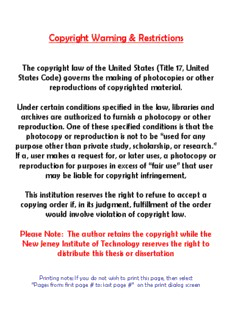
Finite element analysis of skin injuries by water jet cutting PDF
Preview Finite element analysis of skin injuries by water jet cutting
Copyright Warning & Restrictions The copyright law of the United States (Title 17, United States Code) governs the making of photocopies or other reproductions of copyrighted material. Under certain conditions specified in the law, libraries and archives are authorized to furnish a photocopy or other reproduction. One of these specified conditions is that the photocopy or reproduction is not to be “used for any purpose other than private study, scholarship, or research.” If a, user makes a request for, or later uses, a photocopy or reproduction for purposes in excess of “fair use” that user may be liable for copyright infringement, This institution reserves the right to refuse to accept a copying order if, in its judgment, fulfillment of the order would involve violation of copyright law. Please Note: The author retains the copyright while the New Jersey Institute of Technology reserves the right to distribute this thesis or dissertation Printing note: If you do not wish to print this page, then select “Pages from: first page # to: last page #” on the print dialog screen The Van Houten library has removed some of the personal information and all signatures from the approval page and biographical sketches of theses and dissertations in order to protect the identity of NJIT graduates and faculty. ABSTRACT FINITE ELEMENT ANALYSIS OF SKIN INJURIES BY WATER JET CUTTING by Syed Muhammad Arif High pressure water jets are used in industry for cleaning and cutting purposes. These devices can generate pressure upto 400 MPa. As high pressure water jets become more widespread in industry, injuries will be seen with great frequency. Penetrating injuries by these devices can produce minimal external evidence of extensive soft tissue injury. To know the extent of injury, it is important to study the relationship between operating parameters of water jet and the skin layers. A computational analysis is carried out using finite element method to find the effects of water jet pressure on the skin layer. Finite element skin model is made and the analysis is carried out at different pressure. Linear and non linear static analyses are done here to study the behavior of skin layers under pressure. The results obtained from both analyses shows linear effect that is elastic behavior. The skin materials rupture before going into the plastic region. The results show that the layer of skin will start to shear at about 45 MPa of water jet pressure. The epidermis bears most of the stresses and is deformed, other layers are also deformed but do not reveal high stress concentration. High stress concentration are seen in the dermis where there are not enough collagen fibers. FINITE ELEMENT ANALYSIS OF SKIN INJURIES BY WATER JET CUTTING by Syed Muhammad Arif A Thesis Submitted to the Faculty of New Jersey Institute of Technology in Partial Fulfillment of the Requirements for the Degree of Master of Science in Manufacturing Systems Engineering Department of Industrial and Manufacturing Engineering May 1997 APPROVAL PAGE FINITE ELEMENT ANALYSIS OF SKIN INJURIES BY WATER JET CUTTING Syed Muhammad Arif Dr. Ge rge Hanna Abdou, Thesis Advisor Date o Associate Professor of Industrial and Manufacturing Engineering, NJIT. Err. Tin(aTa:x ni4 Chu, Committee Member Date Assistant Professor of Mechanical Engineering, NJIT. Dr. Carl Wolf, Committee Member Date Professor of Industrial and Manufacturing Engineering, NJIT. BIOGRAPHICAL SKETCH Author : Syed Muhammad Arif Degree : Master of Science Date : May 1997 Undergraduate and Graduate Education • Master of Science in Manufacturing Systems Engineering, New Jersey Institute of Technology, Newark; NJ,' 100 • Bachelor of Science in Mechanical Engineering, N.E.D University of Engineering and Technology, Karachi, Pakistan, 1995 Major : Manufacturing Systems Engineering iv ACKNOWLEDGMENT The author wishes to thank his thesis advisor, Prof. George Abdou, for patiently reviewing the progress of the thesis at every stage and helping him to plan it efficiently. This thesis would not have been successful but for his invaluable guidance, continuous motivation and sincere concern. Further, I would like to express my gratitude to Dr. Carl Wolf, and Dr. Tina Chu for serving as committee members and providing necessary guidance for this work. Thanks also to the librarians at NJIT for their help in survey of research papers relevant to the thesis topic. Lastly, thanks to all my friends for their support and cooperation. vi To my beloved Parents TABLE OF CONTENTS Chapter Page 1 INTRODUCTION 1 1.1 Water Jet Cutting Capabilities 2 1.2 Problem Definition 4 2 LITERATURE REVIEW 6 2.1 Injuries Caused by Water Jet Process 6 2.2 Water Jet as a Surgical Tool 10 2.3 Finite Element Analysis in Soft Tissue Mechanics 12 2.4 Limitations 15 3 OBJECTIVES AND PROCEDURES 17 4 PROPOSED METHODOLOGY 19 4.1 Water Jet and its Operating Parameters 19 4.1.1 Operating Principle 21 4.2 Structure and Mechanical Properties of Skin 25 4.2.1 Mechanical Role of the Skin Component 26 4.3 Finite Element Method 29 4.3.1 Linear Static Analysis 34 4.3.2 Nonlinear Static Analysis 34 4.4 NISA (Finite Element Analysis Software) 35 4.5 Modules of Modeling/Analysis 36 4.5.1 Geometric Modeling 36 vii TABLE OF CONTENTS (continued) Chapter Page 4.5.2 Meshing Modules 37 4.5.3 Model Verification 37 4.5.4 Analysis Modules 37 4.5.5 Post Processing 38 5 CASE STUDY AND RESULTS 40 5.1 Assumptions 40 5.2 Construction of Finite Element Skin Model 41 5.2.1 Geometric Modeling 41 5.2.2 Finite Element Modeling 42 5.3 Boundary Conditions and Loading 49 5.4 Element and Material Properties 50 5.5 Results 55 6 ANALYSIS OF RESULTS 60 7 CONCLUSIONS AND RECOMMENDATIONS 68 APPENDICES 71 APPENDIX A NISA INPUT FILE (SKIN.NIS) 71 APPENDIX B RESULTS OF THE ANALYSIS AT 10 MPa 130 REFERENCES 147 GLOSSARY 149
Description: